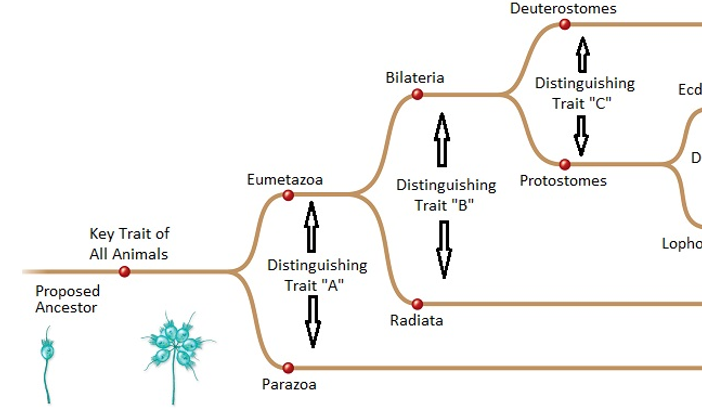A) sharks
B) tuna
C) salmon
D) lampreys
E) skates
G) A) and E)
Correct Answer

verified
Correct Answer
verified
Multiple Choice
Which of the following is not an example of a mammal?
A) dolphin
B) whale
C) platypus
D) penguin
E) kangaroo
G) B) and E)
Correct Answer

verified
Correct Answer
verified
True/False
Figuer:
Main animal groups are noted at the right. Names diverging at each node are morphological or body form names. Note that the animal traits key to distinguishing the groups and body forms are not shown.  -If an animal researcher reproduces this evolutionary tree,but rotates the body forms and animal groups,showing the Deuterostomes beneath the Protostomes,the interpretation of common ancestry and divergence among the body forms and animal groups will completely change.
-If an animal researcher reproduces this evolutionary tree,but rotates the body forms and animal groups,showing the Deuterostomes beneath the Protostomes,the interpretation of common ancestry and divergence among the body forms and animal groups will completely change.
B) False
Correct Answer

verified
Correct Answer
verified
Multiple Choice
Mammals that lay eggs are
A) monotremes.
B) bats.
C) placentals.
D) birds.
E) marsupials.
G) B) and D)
Correct Answer

verified
Correct Answer
verified
Multiple Choice
Cnidarians all share the ability to do which of the following?
A) live on land
B) secrete enzymes to digest food
C) sting predators and prey
D) fly
E) photosynthesize
G) C) and D)
Correct Answer

verified
Correct Answer
verified
Multiple Choice
Sea cucumbers and sea urchins belong to the phylum containing the
A) Arthropods.
B) Echinoderms.
C) Mollusks.
D) Nematodes.
E) Cnidarians.
G) A) and C)
Correct Answer

verified
Correct Answer
verified
Multiple Choice
In animals,a sphere of embryonic cells surrounding a fluid-filled cavity is called a
A) coelom.
B) gastrovascular cavity.
C) hydrostatic skeleton.
D) blastula.
E) gastrula.
G) B) and D)
Correct Answer

verified
Correct Answer
verified
Multiple Choice
Which of the following were the first vertebrates to live and reproduce in dry environments?
A) mammals
B) birds
C) fish
D) reptiles
E) amphibians
G) B) and E)
Correct Answer

verified
Correct Answer
verified
Multiple Choice
The embryonic germ layer of tissue in animals that develops into the skin and nervous system is the
A) endoderm.
B) mesoderm.
C) pachyderm.
D) protoderm.
E) ectoderm.
G) C) and E)
Correct Answer

verified
Correct Answer
verified
Multiple Choice
Which of the following is not a characteristic of an annelid?
A) They have a coelom.
B) They are segmented.
C) They have bilateral symmetry.
D) They have organ systems.
E) They have an incomplete digestive tract.
G) A) and E)
Correct Answer

verified
Correct Answer
verified
Multiple Choice
Earthworms have multiple hearts that pump blood throughout the body in vessels.They also ingest soil,digest the organic matter,and eliminate the indigestible particles as castings.Earthworms have which of the following?
A) a complete digestive tract and open circulatory system
B) a complete digestive tract and closed circulatory system
C) an incomplete digestive tract and closed circulatory system
D) an incomplete digestive tract and open circulatory system
F) B) and D)
Correct Answer

verified
Correct Answer
verified
Multiple Choice
Leeches and earthworms belong to the phylum containing the
A) Nematodes.
B) Flatworms.
C) Sponges.
D) Annelids.
E) Mollusks.
G) A) and B)
Correct Answer

verified
Correct Answer
verified
Multiple Choice
Which of the following is not a characteristic of amphibians?
A) They have a three-chambered heart.
B) They are ectothermic.
C) They have a cartilaginous skeleton.
D) They do not have an amnion.
E) They have vertebrae.
G) All of the above
Correct Answer

verified
Correct Answer
verified
Multiple Choice
Which of the following is a trait shared by mammals and reptiles that is not shared by the other groups of chordates?
A) an amnion
B) hair
C) mammary glands
D) legs
E) lungs
G) B) and D)
Correct Answer

verified
Correct Answer
verified
Multiple Choice
The embryonic germ layer of tissue in animals that develops into the muscles and reproductive system is the
A) endoderm.
B) protoderm.
C) mesoderm.
D) pachyderm.
E) ectoderm.
G) A) and C)
Correct Answer

verified
Correct Answer
verified
Multiple Choice
In the fossil record,there is evidence that feathers were produced by which of the following?
A) birds
B) dinosaurs
C) birds and some dinosaurs
D) mammals
E) birds and some mammals
G) C) and D)
Correct Answer

verified
Correct Answer
verified
Multiple Choice
Although animals as complicated as the sponges exist in the fossil record before 530 MYA,the common phyla we can observe in living animals now appear in the fossil record only abruptly in a short span of 25 million years.When researchers analyzed the DNA evidence that might relate sponges to the modern phyla,what unexpected result did they find?
A) The entire genome of sponges was found to be very different in gene diversity from the genomes of other phyla.
B) Samples of the living sponge, Oscarella carmela, were found to be relatively unchanged from fossil sponge DNA samples.
C) DNA evidence indicated clearly that a sponge like Oscarella carmela was the common ancestor of eumetazoans.
D) All of these answer options are correct in expressing unexpected results from the research.
E) Many development genes thought to be specific to eumetazoans were found in sponges.
G) A) and B)
Correct Answer

verified
Correct Answer
verified
Multiple Choice
According to the fossil record,which of the following were the first vertebrates to appear on land?
A) amphibians
B) fish
C) reptiles
D) birds
E) mammals
G) B) and D)
Correct Answer

verified
Correct Answer
verified
True/False
Birds are endothermic,feathered reptiles.
B) False
Correct Answer

verified
Correct Answer
verified
Multiple Choice
Sponges are
A) plants.
B) prokaryotic bacteria.
C) the most complex protists.
D) the simplest animals.
E) not alive.
G) B) and D)
Correct Answer

verified
Correct Answer
verified
Showing 61 - 80 of 86
Related Exams